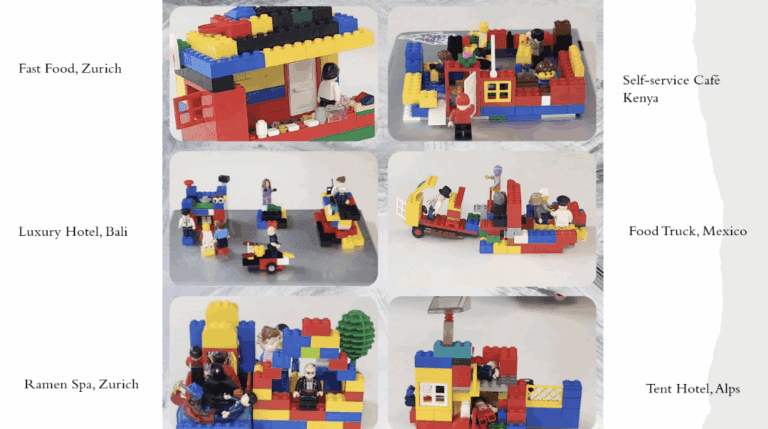Based on the above statement, LEGO® Serious Play® (LSP) is a facilitated thinking, communication, and problem-solving technique that uses LEGO bricks as a medium for creative expression and strategic dialogue. LSP, originally developed by LEGO Group executives Robert Rasmussen & Per Kristiansen in 2001, was intended to promote innovation and collaboration among corporate environments.
What is LEGO Serious play?
LSP’s core concept is to build with Lego bricks based on the notion that hands-on and minds-on learning will unlock deeper insights, fostering more inclusive conversations. This can be a fun way to get participants to think outside the box. They will come up with new ideas and solutions they would not have thought of otherwise. The LSP method follows a structured approach with a facilitator guiding participants in the following manner:
Build – Participants construct models using LEGO bricks in response to a facilitator’s question or statement. Participants are often given a limited number of LEGO bricks to work with and must be creative to reach the goal.
Share – Each participant explains the meaning behind their model.
Reflect/Listen – The group listens without interruption, promoting equal participation and deeper understanding. This approach encourages storytelling, metaphorical thinking and reflection. It is a powerful tool to break the ice, build a team, develop strategy and gain personal insight.
LEGO Serious Play: Benefits
Inclusivity: LSP level the playing fields by giving everyone an equal voice, no matter their status or style of communication.
Engagement: LEGO bricks have a tactile quality that keeps participants active.
Creativity: Encourages the use of metaphorical reasoning and thinking outside the box.
Reflection: Individuals can access deeper insights by sharing their personal stories.
LEGO Serious Play’s Key Principles are:
Everyone Participates, Everyone Contributes
LSP ensures 100% participation. The conversation is democratized and the collective intelligence is tapped into when each participant shares and builds. This is also an excellent opportunity for ice-breaker activities, because everyone talks and creates.
Leaders don’t have all the answers
This method is based on the assumption that insights are available at any level within an organization. It encourages all voices to be heard, not only those with leadership positions. Participants will describe models and ideas. This is an opportunity to brainstorm through building.
The System Has the Answer
LSP sees organizations as adaptive complex systems. The method uncovers hidden knowledge and connections within the group. This leads to holistic solutions. By building models for each participant and connecting them to a central idea, the method can assist in finding solutions.
Hands-On, Minds-On Learning
LEGO bricks stimulate both the brain and the hands, activating cognitive processes. This tactile engagement allows participants to express their ideas verbally that they would otherwise struggle with and generate creative ideas.
Metaphorical thinking enhances understanding
Participants create models to represent abstract concepts metaphorically. It allows for a deeper exploration of concepts, and encourages innovative and creative problem-solving.
The process is the product
LSP isn’t just about the models. It’s also about the stories that are told and the reflections that people share. The process generates insights and promotes alignment. The end result can often be a new business idea.
Psychological Safety and Equal Voice
The format is structured to ensure that everyone gets equal time for building and sharing, creating an open space and reducing the dominance of louder voices. All participants follow along with the facilitator’s steps. This helps them feel confident, and they can be more open in the group.
Reflection is integral
After sharing and building, participants take time to reflect on the information they have received. This step helps to deepen understanding and integrate insights into practical outcomes. It will also encourage introverts to speak up in groups.
How LSP is used in hospitality:
- Staff Development and Training
– Scenario Building: Employees can build models representing challenging guest interactions and explore solutions together.
– Empathy Training: Staff can create models that reflect guest experiences, helping them understand different perspectives.
– Team Bonding: LSP encourages open communication and trust, which is essential in high-pressure hospitality environments.
2. Service Design and Innovation
– Customer Journey Mapping: Teams can build the guest journey from check-in to check-out, identifying pain points and opportunities for improvement.
– New Service Prototyping: Use LSP to visualize and test new service concepts before implementation.
– Feedback Integration: Incorporate guest feedback into model-building sessions to co-create better experiences.
– New products and services can be designed as Lego models and then pitched to investors for funding in order to be actualized
3. Leadership and strategy
– Vision and Values Alignment: Leaders and teams can build models that represent the organization’s mission and values, aligning everyone’s understanding.
– Strategic Planning: Use LSP to explore future scenarios, risks, and opportunities in a collaborative way.
– Change Management: Help teams visualize and emotionally process organizational changes.
4. Enhancing Guest Experience
– Role-Playing with Models: Simulate guest interactions to refine service delivery.
– Problem Solving: Address recurring guest complaints by modeling the service environment and brainstorming improvements.
5. Cross-Department Collaboration
– Breaking Silos: LSP sessions can bring together housekeeping, front desk, F&B, and management to co-create solutions. LSP sessions can be used to break the ice and introduce members to new teams.
– Shared Understanding: Building models helps different departments understand each other’s challenges and contributions.
– Building Teams: LSP sessions can bring people together and work perfectly for team building.
You can also follow the links to LinkedIn posts that show how I use it in my modules.



